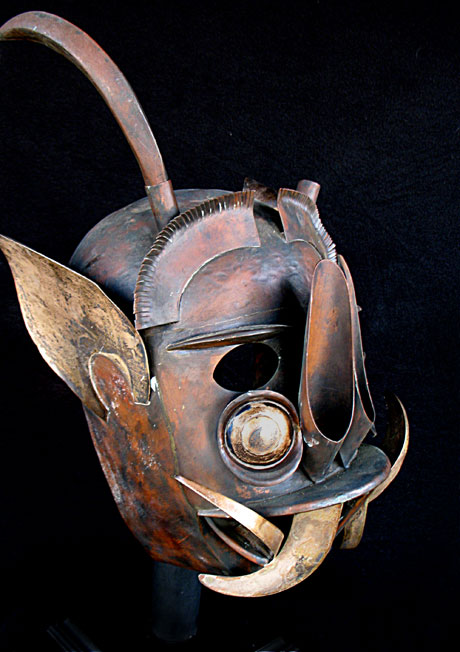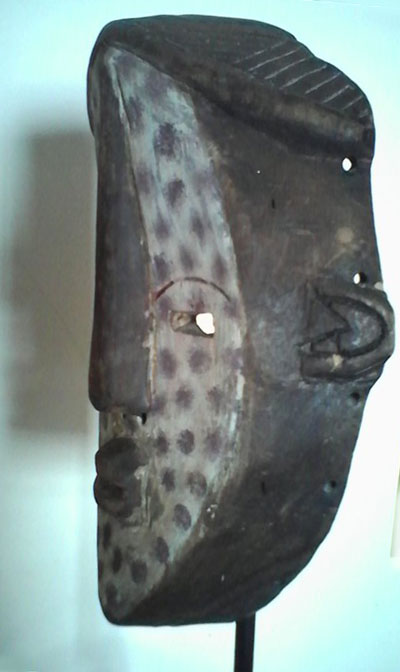 Q: This unusual mask was a total mystery when I bought it, but now I would like to share it with you and your visitors. I got it for some 70 usd at a thrift shop. It had a tag with a telephone number and said ‘Bottega Artigiana per lo studio delle arti popolari’, and there is a logo branded in the inside. It was made by Gian Pietro Angelo in the town of Macomer on the island of Sardinia, Italy. I guess it is of Mediterranean pine tree, and has a bright red water color with dark varnish, which gives the mask an incredibly gloomy red color. The ring is of brass. The mask is a perfect copy of a 2500 years old terracotta mask from the antiquities which was found in1876 in the Sardinia location of San Sperate. There existed an ancient necropolis, and these so-called ‘grinning masks’ (maschera ghignante) were probably used in the tombs as talismans for the dead in order to fend off evil spirits. Archeologists believe that these objects are of Phoenician or Carthago origin and got imported into Sardinia and Sicilia by the time of the Punic Wars. So, the mask is carved very well, light and fits perfectly on the face. However, it does not seem to be a recurrent design of Sardinia carnival tradition, as I did not find any other mask like this on the internet but just one: a member of the Tumbarinos di Gavoi (Drummers of Gavoi) wears almost exactly the same mask – I am sure it’s from the same carver. So enjoy it, and any additional comments, maybe also from specialists of Sardinian masks, would be very welcomed.
Q: This unusual mask was a total mystery when I bought it, but now I would like to share it with you and your visitors. I got it for some 70 usd at a thrift shop. It had a tag with a telephone number and said ‘Bottega Artigiana per lo studio delle arti popolari’, and there is a logo branded in the inside. It was made by Gian Pietro Angelo in the town of Macomer on the island of Sardinia, Italy. I guess it is of Mediterranean pine tree, and has a bright red water color with dark varnish, which gives the mask an incredibly gloomy red color. The ring is of brass. The mask is a perfect copy of a 2500 years old terracotta mask from the antiquities which was found in1876 in the Sardinia location of San Sperate. There existed an ancient necropolis, and these so-called ‘grinning masks’ (maschera ghignante) were probably used in the tombs as talismans for the dead in order to fend off evil spirits. Archeologists believe that these objects are of Phoenician or Carthago origin and got imported into Sardinia and Sicilia by the time of the Punic Wars. So, the mask is carved very well, light and fits perfectly on the face. However, it does not seem to be a recurrent design of Sardinia carnival tradition, as I did not find any other mask like this on the internet but just one: a member of the Tumbarinos di Gavoi (Drummers of Gavoi) wears almost exactly the same mask – I am sure it’s from the same carver. So enjoy it, and any additional comments, maybe also from specialists of Sardinian masks, would be very welcomed.
A: Thanks for taking the time to write this detailed description of your interesting mask. There’s nothing I can add other than you got it for a good price. B+





2 Comments
Eric Paroissien
Google image: phoenician mask
See the similarities in details like the three different flowers in line on the forehead, and the one on the chin.
Steven Jensen
I’ve encountered a mask like this before while traveling through Western Europe. This seems to be of Sicilian make. However, the one I found was blue with silver attachments. I discovered it in an abandoned monastery. I brought it back to the nearest village and they informed me that it was a prayer mask. Circa 1460-1500 BCE.